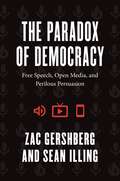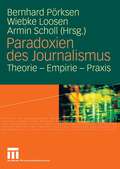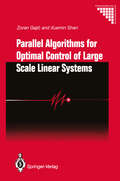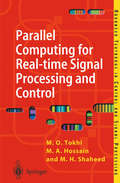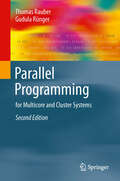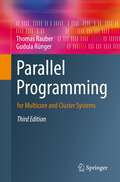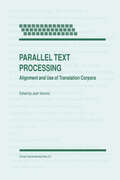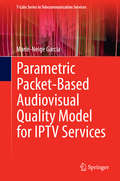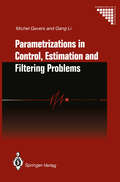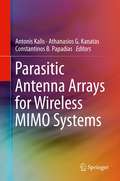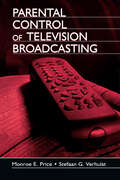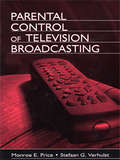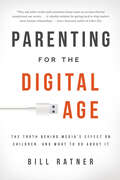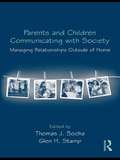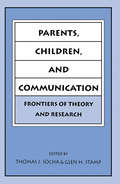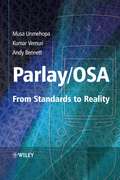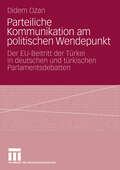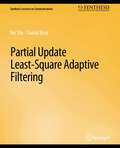- Table View
- List View
The Paradox of Democracy: Free Speech, Open Media, and Perilous Persuasion
by Zac Gershberg Sean IllingA thought-provoking history of communications that challenges ideas about freedom of speech and democracy. At the heart of democracy lies a contradiction that cannot be resolved, one that has affected free societies since their advent: Though freedom of speech and media has always been a necessary condition of democracy, that very freedom is also its greatest threat. When new forms of communication arrive, they often bolster the practices of democratic politics. But the more accessible the media of a society, the more susceptible that society is to demagoguery, distraction, and spectacle. Tracing the history of media disruption and the various responses to it over time, Zac Gershberg and Sean Illing reveal how these changes have challenged democracy—often with unsettling effects. The Paradox of Democracy captures the deep connection between communication and political culture, from the ancient art of rhetoric and the revolutionary role of newspapers to liberal broadcast media and the toxic misinformation of the digital public sphere. With clear-eyed analysis, Gershberg and Illing show that our contemporary debates over media, populism, and cancel culture are not too different from the democratic cultural experiences of the past. As we grapple with a fast-changing, hyper-digital world, they prove democracy is always perched precipitously on a razor’s edge, now as ever before.
Paradoxien des Journalismus: Theorie - Empirie - Praxis
by Bernhard Pörksen Wiebke Loosen Armin SchollParallel Algorithms for Optimal Control of Large Scale Linear Systems (Communications and Control Engineering)
by Zoran Gajic Xuemin ShenParallel Algorithms for Optimal Control of Large Scale Linear Systems is a comprehensive presentation for both linear and bilinear systems. The parallel algorithms presented in this book are applicable to a wider class of practical systems than those served by traditional methods for large scale singularly perturbed and weakly coupled systems based on the power-series expansion methods. It is intended for scientists and advance graduate students in electrical engineering and computer science who deal with parallel algorithms and control systems, especially large scale systems. The material presented is both comprehensive and unique.
Parallel Computing for Real-time Signal Processing and Control (Advanced Textbooks in Control and Signal Processing)
by M. Osman Tokhi M. Alamgir Hossain M. Hasan ShaheedThis book introduces the advantages of parallel processing and details how to use it to deal with common signal processing and control algorithms. The text includes examples and end-of-chapter exercises, and case studies to put theoretical concepts into a practical context.
Parallel Programming: for Multicore and Cluster Systems
by Thomas Rauber Gudula RüngerInnovations in hardware architecture, like hyper-threading or multicore processors, mean that parallel computing resources are available for inexpensive desktop computers. In only a few years, many standard software products will be based on concepts of parallel programming implemented on such hardware, and the range of applications will be much broader than that of scientific computing, up to now the main application area for parallel computing.Rauber and Rünger take up these recent developments in processor architecture by giving detailed descriptions of parallel programming techniques that are necessary for developing efficient programs for multicore processors as well as for parallel cluster systems and supercomputers. Their book is structured in three main parts, covering all areas of parallel computing: the architecture of parallel systems, parallel programming models and environments, and the implementation of efficient application algorithms. The emphasis lies on parallel programming techniques needed for different architectures. For this second edition, all chapters have been carefully revised. The chapter on architecture of parallel systems has been updated considerably, with a greater emphasis on the architecture of multicore systems and adding new material on the latest developments in computer architecture. Lastly, a completely new chapter on general-purpose GPUs and the corresponding programming techniques has been added.The main goal of the book is to present parallel programming techniques that can be used in many situations for a broad range of application areas and which enable the reader to develop correct and efficient parallel programs. Many examples and exercises are provided to show how to apply the techniques. The book can be used as both a textbook for students and a reference book for professionals. The material presented has been used for courses in parallel programming at different universities for many years.
Parallel Programming: for Multicore and Cluster Systems
by Thomas Rauber Gudula RüngerThis textbook covers the new development in processor architecture and parallel hardware. It provides detailed descriptions of parallel programming techniques that are necessary for developing efficient programs for multicore processors as well as for parallel cluster systems and supercomputers. The book is structured in three main parts, covering all areas of parallel computing: the architecture of parallel systems, parallel programming models and environments, and the implementation of efficient application algorithms. The emphasis lies on parallel programming techniques needed for different architectures. In particular, this third edition includes an extended update of the chapter on computer architecture and performance analysis taking new developments such as the aspect of energy consumption into consideration. The description of OpenMP has been extended and now also captures the task concept of OpenMP. The chapter on message-passing programming has been extended and updated to include new features of MPI such as extended reduction operations and non-blocking collective communication operations. The chapter on GPU programming also has been updated. All other chapters also have been revised carefully. The main goal of this book is to present parallel programming techniques that can be used in many situations for many application areas and to enable the reader to develop correct and efficient parallel programs. Many example programs and exercises are provided to support this goal and to show how the techniques can be applied to further applications. The book can be used as a textbook for students as well as a reference book for professionals. The material of the book has been used for courses in parallel programming at different universities for many years.
Parallel Text Processing: Alignment and Use of Translation Corpora (Text, Speech and Language Technology #13)
by Jean Véronisl This book evolved from the ARCADE evaluation exercise that started in 1995. The project's goal is to evaluate alignment systems for parallel texts, i. e. , texts accompanied by their translation. Thirteen teams from various places around the world have participated so far and for the first time, some ten to fifteen years after the first alignment techniques were designed, the community has been able to get a clear picture of the behaviour of alignment systems. Several chapters in this book describe the details of competing systems, and the last chapter is devoted to the description of the evaluation protocol and results. The remaining chapters were especially commissioned from researchers who have been major figures in the field in recent years, in an attempt to address a wide range of topics that describe the state of the art in parallel text processing and use. As I recalled in the introduction, the Rosetta stone won eternal fame as the prototype of parallel texts, but such texts are probably almost as old as the invention of writing. Nowadays, parallel texts are electronic, and they are be coming an increasingly important resource for building the natural language processing tools needed in the "multilingual information society" that is cur rently emerging at an incredible speed. Applications are numerous, and they are expanding every day: multilingual lexicography and terminology, machine and human translation, cross-language information retrieval, language learning, etc.
Parameterextraktion bei Halbleiterbauelementen: Simulation mit PSPICE
by Peter BaumannErgänzend zu Vorlesung, zu Rechenübungen und insbesondere zum Laborpraktikum im Lehrfach Elektronik werden Analyseverfahren zur Extraktion von SPICE-Modellparametern ausgewählter Halbleiterbauelemente vorgestellt. Für Bauelemente aus der DEMO-Version des Programms ORCAD-PSPICE wird aufgezeigt, wie man deren statische und dynamische elektrische Modellparameter mit PSPICE-Analysen wieder zurück gewinnen kann. Diese Parameterermittlung wird ausgeführt für Schaltdiode, Kapazitätsdiode, npn-Bipolartransistor, N-Kanal-Sperrschicht-Feldeffekttransistor, CMOS-Array-Transistoren, Operationsverstärker und Optokoppler. In einem neuen Abschnitt werden Streuparameter-Analysen zum bipolaren HF-Transistor vorgenommen. Behandelt wird ferner die Ermittlung der Modellparameter von Sensoren zur Erfassung von Temperatur, Licht, Feuchte, Kraft, Schall, Gaskonzentration und pH-Wert. Das abschließende neue Kapitel widmet sich der Parameterextraktion von multikristallinen, monokristallinen und Dünnschicht-Silizium-Solarzellen.
Parametric Packet-based Audiovisual Quality Model for IPTV services (T-Labs Series in Telecommunication Services)
by Marie-Neige GarciaThis volume presents a parametric, packet-based, comprehensive model to measure and predict the audiovisual quality of Internet Protocol Television services as it is likely to be perceived by the user. The comprehensive model is divided into three sub-models referred to as the audio model, the video model, and the audiovisual model. The audio and video models take as input a parametric description of the audiovisual processing path, and deliver distinct estimates for both the audio and video quality. These distinct estimates are eventually used as input data for the audiovisual model. This model provides an overall estimate of the perceived audiovisual quality in total. The parametric description can be used as diagnostic information. The quality estimates and diagnostic information can be practically applied to enhance network deployment and operations. Two applications come to mind in particular: Network planning and network service quality monitoring. The audio model can be used indifferently for both applications. However, two variants of the video model have been developed in order to address particular needs of the applications mentioned above. The comprehensive model covers effects due to resolution, coding, and IP-packet loss in case of RTP-type transport. The model applied to quality monitoring is standardized under the ITU-T Recommendations P.1201 and P.1201.2.
Parametrizations in Control, Estimation and Filtering Problems: Accuracy Aspects (Communications and Control Engineering)
by Michel Gevers Gang LiThis book is all about finite wordlength errors in digital filters, con trollers and estimators, and how to minimize the deleterious effects of these errors on the performance of these devices. This does by no means imply that all about finite wordlength errors in filters, controllers and estimators is to be found in this book. We first ventured into the world of finite wordlength effects in 1987 when Gang Li began his PhD thesis in this area. Our more experienced readers might well say 'This shows', but we believe that the extent of our new contributions largely offsets our relative inexperience about the subject that might surface here and there in the book. Our naive view on the subject of finite wordlength errors in 1987 could probably be summarized as follows: • numerical errors due to finite wordlength encoding and roundoff are something that one has to live with, and there is probably not much that can be done about them except to increase the wordlength by improvements on the hardware; • these errors are as old as finite arithmetic and numerical analysis and they must therefore be well understood by now; • thus, if something can be done to minimize their effects, it must have been analysed and put into practice a long time ago. It is almost fair to say that we were wrong on all counts.
Parasitic Antenna Arrays for Wireless MIMO Systems
by Antonis Kalis Athanasios G. Kanatas Constantinos B. PapadiasThis book unites two different technologies: parasitic antenna arrays driven via analogue circuits that control the electromagnetic waves generated by the antenna array; and MIMO technology for multi-antenna arrays, typically driven by digital techniques in the baseband domain. The combination of these two technologies has revealed a novel functionality that breaks through the conventional MIMO paradigm, allowing MIMO transmission over the air with the use of antenna arrays that may consist of only a single active element, that is surrounded by a number of passive neighboring antennas. The contributions in the book show the capability of such systems to also perform MIMO transmission. This fact holds the potential of revolutionizing the way small-form wireless terminals operate and seems to set the scene for a win-win situation, achieving MIMO transmission with very small and cheap antenna arrays. The book is structured to provide a well-rounded treatment of the various facets of this newly discovered wireless communication capability. All relevant technical angles, ranging from information theoretic to electromagnetic considerations; from analogue circuit to digital baseband control for signal generation; and from channel modeling to communication theoretic aspects are taken into account. A good balance between theory, practical considerations and over-the-air experimentation is proposed and reflected in the chapter outline. Finally, a discussion and early evidence related to potential applications as well as the relevance to current and upcoming wireless standards is provided.
Pardon My French: Unleash Your Inner Gaul
by Charles TimoneyTHINGS YOU DIDN'T KNOW ABOUT FRANCE: You burnt Joan of Arc! ? Smuggling live chickens into rugby matches is patriotic ? How many times to kiss on the cheek ? Where not to cross the road ? French guns don't go 'bang' ? What do you call a party? ? bon appetit is vulgar ? A six-pack is a bar of chocolate ? The dangers of being called Peter or Penny ? Your smallest finger is your 'ear' finger ? The importance of Wednesdays ? How to tip ? and when to celebrate Christmas? Forget the French you learnt at school. Based on twenty years of hard-won knowledge, Pardon My French takes you through all the words you need to survive, shows how and why they work, and steers you past all the pitfalls and potential embarrassments of speaking French in France. From sugar-cube etiquette to why the Marseillaise is all about slaughtering Austrians and Prussians as bloodily as possible, Charles Timoney lays bare the Gallic mindset alongside their bizarre language. Covering all areas of everyday life from eating and drinking to travel, work and, crucially, swearing and sounding like a teenager, this is not just the most entertaining, but also the most useful book on France and the French you'll ever read.
Parental Control of Television Broadcasting (Routledge Communication Series)
by Monroe E. Price Stefaan VerhulstThis project, originally developed for the European Community, examines parental roles in controlling television programs watched by children in Europe. The structure of the study includes: *an analysis of the technical devices available to assist in parental control of television broadcasting services, including descriptions of devices, their cost, availability, and the infrastructure needed to introduce them; *a corresponding analysis of potential ratings or labeling systems to work in conjunction with or in the place of technical devices, enabling a comparative analysis of rating systems used in film, video, and online services; and *an overview and assessment of the educational and awareness measures in the field of protection of minors and harmful content, providing the data for the review of available considerations in this field of viewer literacy. In addition to these main strands of analysis, the study provides for background information and analysis in the following areas: *an overview of the main media theories focusing on the effect and impact of specific types of content on children and their behavior; *an assessment of the economic impact and social efficacy of different protective measures; and *a comparison of the regulatory contexts and rating systems for film, video, television, and online services concerning the protection of minors from harmful content. This volume is intended for scholars and students in comparative media studies, media policy, and regulation.
Parental Control of Television Broadcasting (Routledge Communication Series)
by Monroe E. Price Stefaan VerhulstThis project, originally developed for the European Community, examines parental roles in controlling television programs watched by children in Europe. The structure of the study includes: *an analysis of the technical devices available to assist in parental control of television broadcasting services, including descriptions of devices, their cost, availability, and the infrastructure needed to introduce them; *a corresponding analysis of potential ratings or labeling systems to work in conjunction with or in the place of technical devices, enabling a comparative analysis of rating systems used in film, video, and online services; and *an overview and assessment of the educational and awareness measures in the field of protection of minors and harmful content, providing the data for the review of available considerations in this field of viewer literacy. In addition to these main strands of analysis, the study provides for background information and analysis in the following areas: *an overview of the main media theories focusing on the effect and impact of specific types of content on children and their behavior; *an assessment of the economic impact and social efficacy of different protective measures; and *a comparison of the regulatory contexts and rating systems for film, video, television, and online services concerning the protection of minors from harmful content. This volume is intended for scholars and students in comparative media studies, media policy, and regulation.
Parenting for the Digital Age: The Truth Behind Media's Effect on Children and What to Do About It
by Bill RatnerMalin Akerman's at-home parenting read (Buzzfeed)! Bill Ratner, a long-time Hollywood insider and voice of their movie trailers, explores with in-depth research the change in advertising since 1982 and what children are currently exposed to. As a parent, educator, and veteran insider to the world of television, movies, and new media, Ratner talks openly about the problems associated with excessive screen time, children's advertising, and what parents can do about it.
Parents and Children Communicating with Society: Managing Relationships Outside of the Home (Routledge Communication Series)
by Thomas J. Socha Glen StampThe volume opens a new frontier in parent-child communication research as it brings together veteran researchers and newcomers to explore the communication of parents and children as they create relationships outside the family. The chapters herein examine communication processes and problems of parents and children as they interact with childcare, healthcare, education, and youth sports; investigate the unique challenges facing various types of families as they communicate outside the family (e.g., stepfamilies and gay/lesbian/bisexual families); and consider the role of media in family relationships outside of home. The primary audiences for the volume includes scholars, researchers and graduate students studying communication in families, children’s communication, communication in personal relationships, organizational communication, group communication, and health communication. It will also be of interest to psychologists who study families, children, and organizations; sociologists who study families, children, and organizations; education researchers; teachers; coaches; family physicians; and family therapists. graduate students It has the potential for use in courses in family communication, family studies, family sociology, and child development.
Parents and Children Communicating with Society: Managing Relationships Outside of the Home (Routledge Communication Series)
by Thomas J. Socha Glen StampThe volume opens a new frontier in parent-child communication research as it brings together veteran researchers and newcomers to explore the communication of parents and children as they create relationships outside the family. The chapters herein examine communication processes and problems of parents and children as they interact with childcare, healthcare, education, and youth sports; investigate the unique challenges facing various types of families as they communicate outside the family (e.g., stepfamilies and gay/lesbian/bisexual families); and consider the role of media in family relationships outside of home. The primary audiences for the volume includes scholars, researchers and graduate students studying communication in families, children’s communication, communication in personal relationships, organizational communication, group communication, and health communication. It will also be of interest to psychologists who study families, children, and organizations; sociologists who study families, children, and organizations; education researchers; teachers; coaches; family physicians; and family therapists. graduate students It has the potential for use in courses in family communication, family studies, family sociology, and child development.
Parents, Children, and Communication: Frontiers of Theory and Research (Routledge Communication Series)
by Thomas J. Socha Glen H. StampThis is the first edited volume in the communication field to examine parent-child interaction. It creates a framework for future research in this growing area -- family communication, and more specifically, parent-child communication -- and also suggests new areas of communication research among parents and children -- cultural, work-related, taboo topics, family sex discussions, conflict, and abuse. Chapter authors provide thorough coverage of theoretical approaches, new methods, and emerging contexts including lesbian/gay parent-child relationships. In so doing, they bring a communication perspective to enduring problems of discipline, adolescent conflict, and physical child abuse. The text highlights various methodological approaches -- both quantitative and qualitative -- including conversation analysis, grounded theory, participant-observation, and phenomenological interviewing of children. It also introduces and surveys various theoretical approaches -- general systems, developmental, cultural, and intergenerational transmission.
Parents, Children, and Communication: Frontiers of Theory and Research (Routledge Communication Series)
by Thomas J. Socha Glen H. StampThis is the first edited volume in the communication field to examine parent-child interaction. It creates a framework for future research in this growing area -- family communication, and more specifically, parent-child communication -- and also suggests new areas of communication research among parents and children -- cultural, work-related, taboo topics, family sex discussions, conflict, and abuse. Chapter authors provide thorough coverage of theoretical approaches, new methods, and emerging contexts including lesbian/gay parent-child relationships. In so doing, they bring a communication perspective to enduring problems of discipline, adolescent conflict, and physical child abuse. The text highlights various methodological approaches -- both quantitative and qualitative -- including conversation analysis, grounded theory, participant-observation, and phenomenological interviewing of children. It also introduces and surveys various theoretical approaches -- general systems, developmental, cultural, and intergenerational transmission.
Parlay / OSA: From Standards to Reality
by Musa Unmehopa Kumar Vemuri Andy BennettParlay will enable rapid and cost-effective delivery of services based on telecommunications networks, and will be an essential part of the 3G future. We live in an exciting time. 3G networks are taking off, and as greater bandwidth and communication speeds become available, people are seeking new means by which to increase their interaction potential. Newer and more exciting services are being developed to drive more revenues and to enhance end-user experiences. New technologies are being designed and implemented to supplement and leverage the new capabilities being built into core networks. Parlay/OSA: From Standards to Reality is an accessible primer on network ecosystems and operations today, discussing the need for Parlay, the details of standards, aspects of network evolution and support for legacy systems, and advanced topics from an implementation perspective. The authors examine the potential of the Parlay/OSA (Open Service Access) solution from a number of points of view: business need, service development and service deployment. Parlay/OSA: From Standards to Reality: Provides a comprehensive account and examination of the Parlay technology. Covers standards capabilities and directions, and the twelve Service Capability Features, including call control, mobility management, data session control, generic messaging service and content based charging and policy management. Addresses architectural alternatives and advanced architecture patterns. Provides use cases, architecture, deployment scenarios and advanced topics for further reading. This invaluable resource will provide product managers, software developers, application developers, network architects and engineers, as well as advanced students and researchers in academia and industry with an in-depth understanding of Parlay.
A Parliament of Owls: A Book of Collective Nouns
by Chloe RhodesWhy are geese in a gaggle? Are lions actually proud? And do crows deserve their murderous moniker? Collective nouns are one of the most bizarre and baffling aspects of the English language, and this absorbing book tells the stories of these evocative phrases, exploring and explaining the etymology behind them. Each collective noun summons up the animal or event it describes. But where did they come from? 'A parliament of owls', for example, seems to have its origins in the 1950s children's classic The Chronicles of Narnia in which C.S. Lewis references a phrase from Chaucer, 'the parliament of fowls'. Lewis' version changed 'fowls' to 'owls' and due to the international success of his books it caught on and is now recognised as dictionary compilers as the 'correct' term for a group of owls. Perfect for any history or language buff, this is an entertaining and fascinating look at many of the bizarre phrases which have stood the test of time.
Parteiliche Kommunikation am politischen Wendepunkt: Der EU-Beitritt der Türkei in deutschen und türkischen Parlamentsdebatten
by Didem OzanVorwort Vorwort Diese Arbeit hat der Philosophischen Fakultät der Westfälischen Wilhelms- Universität Münster vorgelegen und wurde im Sommersemester 2008 als Diss- tation angenommen. Mit ihrer Veröffentlichung geht ein bedeutsamer Lebens- schnitt zu Ende. Bereits zu Beginn meines Studiums der Deutschen Philologie standen Fragen zum Wesen des Menschen, zu Humanität, Dialog und Völkerv- ständigung im Mittelpunkt. Diese Fragen spannen sich wie ein roter Faden durch die Arbeit. Der Bereich der Rhetorik war besonders wichtig, da Sprache ein wesentliches Element menschlichen Miteinanders ist. Die Dissertation untersucht die Funktion rhetorischer Mittel im parlamentarischen Dialog. Der komplexe Gegenstand wird erschlossen mit der Theorie des Dialogischen Handlungsspiels. Diese erlaubt, gegensätzlich erscheinende soziale Phänomene wie Kooperation und Konflikt, Eigeninteresse und Respekt mit großem Erkenntnisgewinn in neue Beziehungen zueinander zu setzen. Mein besonderer Dank gilt hier der Betreuerin der Arbeit, Frau Prof. Edda Weigand. Ihren Anregungen habe ich intensive Fortschritte im eigenen wissenschaftlichen Denken zu verdanken. Sie gab mir außerdem die Möglichkeit, mit dem Beitrittsprozess der Türkei zur Europäischen Union ein spannendes interkulturelles Politikfeld linguistisch zu bearbeiten. Ich danke Prof. Thomas Bauer für die Erstellung des Zweitgutachtens. Meine besondere Ehre erweisen möchte ich an dieser Stelle dem im Juni dieses Jahres unerwartet verstorbenen Literaturwissenschaftler Prof. Detlef Kremer, dessen brillante Forschung und erfrischende Lehre mich vom ersten Semester an bis zu meiner mündlichen Promotionsprüfung hin begleitet hat.
Partial Identification in Econometrics and Related Topics (Studies in Systems, Decision and Control #531)
by Vladik Kreinovich Nguyen Ngoc Thach Nguyen Duc Trung Doan Thanh HaThis book covers data processing techniques, with economic and financial application being the unifying theme. To make proper investments in economy, the authors need to have a good understanding of the future trends: how will demand change, how will prices change, etc. In general, in science, the usual way to make predictions is: to identify a model that best fits the current dynamics, and to use this model to predict the future behavior. In many practical situations—especially in economics—our past experiences are limited. As a result, the authors can only achieve a partial identification. It is therefore important to be able to make predictions based on such partially identified models—which is the main focus of this book. This book emphasizes partial identification techniques, but it also describes and uses other econometric techniques, ranging from more traditional statistical techniques to more innovative ones such as game-theoretic approach, interval techniques, and machine learning. Applications range from general analysis of GDP growth, stock market, and consumer prices to analysis of specific sectors of economics (credit and banking, energy, health, labor, tourism, international trade) to specific issues affecting economy such as ecology, national culture, government regulations, and the existence of shadow economy. This book shows what has been achieved, but even more important are remaining open problems. The authors hope that this book will: inspire practitioners to learn how to apply state-of-the-art techniques, especially techniques of optimal transport statistics, to economic and financial problems, andinspire researchers to further improve the existing techniques and to come up with new techniques for studying economic and financial phenomena. The authors want to thank all the authors for their contributions and all anonymous referees for their thorough analysis and helpful comments. The publication of this book—and organization of the conference at which these papers were presented—was supported: by the Ho Chi Minh University of Banking (HUB), Vietnam, and by the Vingroup Innovation Foundation (VINIF). The authors thank the leadership and staff of HUB and VINIF for providing crucial support.
Partial Update Least-Square Adaptive Filtering (Synthesis Lectures on Communications)
by Bei Xie Tamal BoseAdaptive filters play an important role in the fields related to digital signal processing and communication, such as system identification, noise cancellation, channel equalization, and beamforming. In practical applications, the computational complexity of an adaptive filter is an important consideration. The Least Mean Square (LMS) algorithm is widely used because of its low computational complexity ($O(N)$) and simplicity in implementation. The least squares algorithms, such as Recursive Least Squares (RLS), Conjugate Gradient (CG), and Euclidean Direction Search (EDS), can converge faster and have lower steady-state mean square error (MSE) than LMS. However, their high computational complexity ($O(N^2)$) makes them unsuitable for many real-time applications. A well-known approach to controlling computational complexity is applying partial update (PU) method to adaptive filters. A partial update method can reduce the adaptive algorithm complexity by updating part of the weight vector instead of the entire vector or by updating part of the time. In the literature, there are only a few analyses of these partial update adaptive filter algorithms. Most analyses are based on partial update LMS and its variants. Only a few papers have addressed partial update RLS and Affine Projection (AP). Therefore, analyses for PU least-squares adaptive filter algorithms are necessary and meaningful. This monograph mostly focuses on the analyses of the partial update least-squares adaptive filter algorithms. Basic partial update methods are applied to adaptive filter algorithms including Least Squares CMA (LSCMA), EDS, and CG. The PU methods are also applied to CMA1-2 and NCMA to compare with the performance of the LSCMA. Mathematical derivation and performance analysis are provided including convergence condition, steady-state mean and mean-square performance for a time-invariant system. The steady-state mean and mean-square performance are also presented for a time-varying system. Computational complexity is calculated for each adaptive filter algorithm. Numerical examples are shown to compare the computational complexity of the PU adaptive filters with the full-update filters. Computer simulation examples, including system identification and channel equalization, are used to demonstrate the mathematical analysis and show the performance of PU adaptive filter algorithms. They also show the convergence performance of PU adaptive filters. The performance is compared between the original adaptive filter algorithms and different partial-update methods. The performance is also compared among similar PU least-squares adaptive filter algorithms, such as PU RLS, PU CG, and PU EDS. In addition to the generic applications of system identification and channel equalization, two special applications of using partial update adaptive filters are also presented. One application uses PU adaptive filters to detect Global System for Mobile Communication (GSM) signals in a local GSM system using the Open Base Transceiver Station (OpenBTS) and Asterisk Private Branch Exchange (PBX). The other application uses PU adaptive filters to do image compression in a system combining hyperspectral image compression and classification.
Partially Coherent Optical Transmission Theory in Optical Wireless Communication (Optical Wireless Communication Theory and Technology)
by Xizheng KeThis book introduces the theory and research methods of partially coherent optical, points out the significance of this study, analyzes the basic theories involved in partially coherent light, and explains the complete coherence of laser is not a necessary condition for good directivity, and partially spatially coherent optical sources can also produce the same far-field intensity distribution as lasers. This type of beam with good directivity but only partial spatial coherence is called a Gaussian Schell model beam, which can be used as a physical model to describe multimode lasers under certain conditions. This book is applicable to the large number of engineers and technicians involved in wireless optical communication and college teachers. It can also be used as a teaching material for graduate students and senior undergraduates in related fields.
